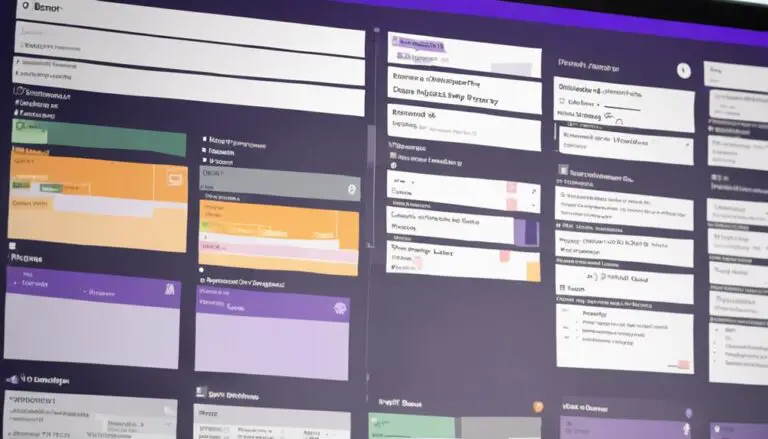In the realm of workflow management, you might be surprised to discover how different processes, despite their unique characteristics, often intersect at key work stages when employing Kanban methodologies. Exploring the concept of kanban ceremonies can help streamline these intersecting processes by establishing regular meetings and reviews to ensure everyone is aligned and progress is being made. By incorporating ceremonies such as daily stand-up meetings and retrospective meetings, teams can better coordinate their efforts and identify potential bottlenecks or inefficiencies. This ultimately leads to a more efficient and effective workflow management system.
The synergy between diverse workflows and Kanban's adaptable framework can pave the way for enhanced productivity and smoother operations. As you explore this intriguing correlation, you'll uncover how these common work stages facilitate a more synchronized and efficient approach to task management, leading to improved outcomes and team collaboration.
Key Takeaways
- Utilizing common work stages like 'To Do,' 'In Progress,' and 'Done' enhances workflow clarity and coordination.
- Implementing WIP limits and monitoring cycle time streamline diverse workflows effectively.
- Adapting Kanban principles to specific processes optimizes task tracking and productivity.
- Standardizing work stages and visualizing progress with Kanban strategies improve efficiency across industries.
Benefits of Applying Kanban to Various Workflows
When implementing Kanban in various workflows, teams experience enhanced clarity and efficiency in managing work stages. Kanban provides a structured approach that allows teams to visualize their progress clearly, identify bottlenecks, and streamline coordination.
By incorporating Kanban into different workflows, teams can standardize workflow stages, leading to improved efficiency and better coordination among team members. The transparency offered by Kanban ensures that everyone is on the same page regarding work progress and upcoming tasks, fostering a sense of unity and shared purpose within the team.
Additionally, applying Kanban to diverse workflows enables workflow optimization by identifying areas for improvement and implementing changes effectively. Overall, the benefits of utilizing Kanban in various workflows include increased transparency, enhanced collaboration, and efficient workflow optimization, ultimately contributing to the overall success and productivity of the team.
Identifying Common Work Stages Across Industries
Common work stages shared across industries offer a standardized framework for tracking tasks and progress on Kanban boards, fostering efficiency and collaboration in workflow management. When identifying common work stages across industries, you'll notice that:
- Teams commonly use work stages such as 'To Do,' 'In Progress,' and 'Done' on their Kanban boards.
- Implementing WIP (work in progress) limits ensures a steady flow of work across different industries.
- Monitoring cycle time helps teams in various sectors track the time taken to complete tasks and improve efficiency.
- Utilizing swim lanes on Kanban boards aids in organizing work based on different categories or team responsibilities.
Adapting Kanban Principles for Diverse Processes
To effectively tailor Kanban principles for various processes, it's crucial to customize workflow stages to suit specific work requirements while maintaining consistency in workflow management.
Different workflows benefit from adapting Kanban principles by incorporating common work stages such as 'To Do,' 'In Progress,' and 'Done' on Kanban boards. By customizing workflow stages, teams can ensure that their unique work requirements are met efficiently. This flexibility in defining stages enables teams to align their Kanban boards with diverse processes effectively.
Standardizing common work stages across different workflows streamlines workflow visualization and coordination in Kanban. Adapting Kanban principles not only allows for the accommodation of variations in processes but also helps teams in maintaining consistency in workflow management. By adapting and customizing workflow stages, teams can optimize their Kanban boards to enhance productivity and workflow efficiency in various processes.
Optimizing Workflows With Kanban Strategies
To enhance workflow efficiency with Kanban strategies, consider implementing work in progress limits to prevent overload and bottlenecks. By setting limits on how many tasks can be in progress at a given time, you can ensure that work moves smoothly through the system without getting stuck, leading to improved efficiency and productivity. Additionally, tracking metrics like cycle time and throughput can help you analyze performance and make necessary improvements.
In optimizing workflows with Kanban strategies, you can also benefit from utilizing Classes of Service and Swimlanes on Kanban boards. These tools help in managing complex projects with multiple workflows by providing a clear structure and prioritization system. Visualizing workflows and combining it with performance analysis is key to achieving continuous improvement in efficiency.
- Implement Work in Progress Limits
- Track Metrics Like Cycle Time and Throughput
- Utilize Classes of Service and Swimlanes
- Combine Visual Workflows with Performance Analysis
Streamlining Processes With Kanban Workstages
When streamlining processes with Kanban workstages, it's essential to establish clear progression paths for tasks to follow through the defined stages.
Kanban workstages, such as To Do, Doing, and Done, provide a structured approach to managing tasks efficiently. By defining common workstages, teams can streamline processes and visualize progress throughout the task lifecycle.
Each workstage represents a specific phase of completion, allowing for a standardized method of managing tasks across different workflows. This progress visualization not only aids in understanding the status of individual tasks but also helps teams identify bottlenecks or areas for improvement.
By incorporating Kanban workstages into your workflow, you can ensure a smoother and more organized process for managing tasks, ultimately enhancing productivity and collaboration within your team.
Improving Productivity Through Kanban Integration
Improving productivity can be achieved through the seamless integration of Kanban methodologies into your workflow. By incorporating Kanban integration, you can experience a significant enhancement in your work processes. Here are some ways in which Kanban integration can help improve productivity:
- Standardized Processes: Aligning workstages through Kanban integration allows for the establishment of standardized processes, reducing variability and increasing efficiency.
- Seamless Transitions: Common workstages in Kanban facilitate smooth transitions between different workflows and tasks, eliminating bottlenecks and delays.
- Cross-Functional Collaboration: Recognizing shared workstages promotes cross-functional collaboration, enabling teams to work together more effectively towards common goals.
- Consistent Workstage Definitions: Kanban integration ensures consistent definitions of workstages, leading to better clarity and understanding among team members about their roles and responsibilities in the process.
Through Kanban integration's emphasis on clear process flow and collaboration, you can optimize productivity and achieve greater success in your projects.
Frequently Asked Questions
What Is Workflow and Workstages in Kanban?
In Kanban, workflow stages are the sequential steps tasks move through, such as To Do and Done. Visual representation aids tracking progress and identifying bottlenecks, enabling continuous improvement, limiting work, fostering team collaboration, and enhancing productivity.
What Are the Stages of Work in Kanban Board?
In your Kanban board, the stages of work – like 'To Do,' 'In Progress,' and 'Done' – guide task prioritization, progress tracking, and team collaboration. Visualizing work, limiting tasks in progress, and analyzing the workflow ensures continuous improvement and optimizes cycle time.
What Is the Main Benefit of Implementing Kanban?
When you implement Kanban, the main benefit is enhanced efficiency. You experience visual transparency, real-time collaboration, and continuous improvement. Productivity increases with streamlined processes, waste reduction, and improved communication.
What Are Three Key Aspects of Kanban?
To grasp Kanban's essence, focus on visual management, WIP limits, and team collaboration. By emphasizing these aspects, you'll streamline processes, boost efficiency, and foster continuous improvement, paving the way for agile productivity enhancements.
Conclusion
As you wrap up your workday, remember how Kanban can revolutionize your workflows. By identifying common work stages and adapting Kanban principles, you can streamline processes and boost productivity.
Imagine the clarity and structure Kanban brings to your tasks, alongside the flexibility and efficiency it offers.
Embrace the power of Kanban integration and watch your teams thrive in a world of continuous improvement.
Elevate your workflow management with Kanban today.





